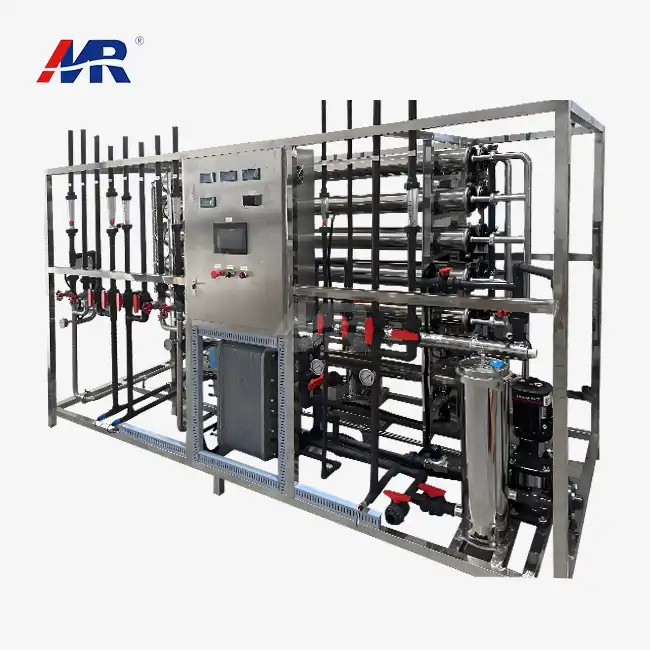EDI's Energy-Efficient Water Purification Process
At the heart of the EDI module lies a revolutionary approach to water purification that prioritizes energy efficiency without compromising on water quality. This innovative technology harnesses the power of electricity and ion-exchange membranes to remove impurities from water, resulting in a process that's not only highly effective but also remarkably energy-conscious.
The Science Behind EDI's Efficiency
The EDI process begins with pre-treated water entering the module. This water, typically already processed through reverse osmosis, contains a low concentration of ions. As it flows through the EDI module, it encounters a series of ion-exchange resins and membranes. An electric field is applied across these components, causing ions to migrate towards their respective electrodes. This migration effectively separates the ions from the water, producing ultra-pure water on one side and a concentrate stream on the other.
What sets EDI apart is its continuous regeneration of ion-exchange resins using the applied electric field. This eliminates the need for chemical regeneration, a process that's both resource-intensive and potentially harmful to the environment. The result is a system that operates with minimal downtime and reduced chemical usage, translating to significant energy savings and operational efficiency.
Comparative Energy Efficiency
When compared to traditional deionization methods, EDI showcases remarkable energy efficiency. For instance, conventional ion exchange systems require frequent regeneration cycles using strong acids and bases, which not only consume energy but also produce chemical waste. In contrast, EDI systems operate continuously with minimal chemical input, reducing both energy consumption and waste generation.
Moreover, the EDI process typically consumes less than 0.5 kWh per cubic meter of treated water, a fraction of the energy required by some alternative purification methods. This low energy footprint makes EDI an attractive option for industries seeking to reduce their overall environmental impact while maintaining high water quality standards.
Waste Reduction: EDI's Circular Economy Approach
In the realm of water treatment, the concept of a circular economy is gaining traction, and EDI technology is at the forefront of this paradigm shift. By minimizing waste and maximizing resource efficiency, EDI systems are helping industries move towards more sustainable operational models.
Minimizing Chemical Waste
One of the most significant advantages of EDI technology is its ability to drastically reduce chemical waste. Traditional water purification methods often rely heavily on chemical regenerants, which not only pose environmental risks but also create a continuous stream of waste that requires proper disposal. The EDI system, on the other hand, operates with minimal chemical input, primarily using electricity to regenerate its ion-exchange resins.
This reduction in chemical usage translates to a substantial decrease in waste generation. Industries that adopt EDI technology often report significant reductions in their chemical waste streams, sometimes by as much as 90%. This not only reduces the environmental burden but also cuts down on the costs associated with chemical procurement and waste disposal.
Water Recovery and Reuse
EDI systems are designed with water efficiency in mind, boasting impressive recovery rates often exceeding 90%. This means that for every 100 liters of feed water, 90 liters or more are converted into high-purity product water. The remaining concentrate, rather than being discarded, can often be recycled back into the treatment process or repurposed for other industrial applications.
This high recovery rate not only conserves water resources but also aligns perfectly with circular economy principles. By maximizing the utilization of water and minimizing waste, EDI technology helps industries close the loop on their water usage, creating more sustainable and resource-efficient operations.
Longevity and Reduced Equipment Waste
The durability and longevity of EDI modules contribute significantly to waste reduction in the long term. Unlike some water treatment technologies that require frequent replacement of components, EDI systems are built to last. With proper maintenance, an EDI module can operate efficiently for many years, reducing the need for frequent replacements and the associated equipment waste.
Furthermore, the simplicity of the EDI design, with fewer moving parts compared to some alternative technologies, means less wear and tear over time. This not only extends the life of the equipment but also reduces the frequency of maintenance interventions, further minimizing waste generation associated with spare parts and maintenance activities.
Sustainable Water Management with EDI Systems
As global water scarcity concerns intensify, the role of sustainable water management becomes increasingly critical. EDI technology emerges as a powerful tool in this context, offering a sustainable approach to water purification that aligns with long-term environmental goals.
Addressing Water Scarcity
EDI systems play a crucial role in addressing water scarcity by enabling the efficient treatment and reuse of water in various industrial processes. The high-purity water produced by EDI can be used in critical applications where water quality is paramount, such as in pharmaceutical manufacturing or semiconductor production. By providing a reliable source of ultra-pure water, EDI technology reduces the demand on freshwater resources, helping industries operate more sustainably in water-stressed regions.
Moreover, the ability of EDI systems to treat brackish or slightly contaminated water sources expands the range of usable water inputs. This flexibility allows industries to tap into alternative water sources, further alleviating pressure on primary freshwater supplies.
Reducing Carbon Footprint
The energy efficiency of EDI technology translates directly into a reduced carbon footprint for water treatment operations. By consuming less energy than many alternative purification methods, EDI systems help industries lower their overall energy consumption and associated greenhouse gas emissions.
Furthermore, the minimal chemical usage in EDI processes means fewer transportation and manufacturing emissions associated with chemical production and delivery. This holistic reduction in carbon emissions aligns with global efforts to combat climate change and positions industries adopting EDI technology as leaders in sustainable water management practices.
Adaptability and Scalability
One of the key strengths of EDI technology in sustainable water management is its adaptability and scalability. EDI systems can be designed to meet a wide range of water purification needs, from small-scale laboratory applications to large industrial installations. This flexibility allows industries to implement sustainable water management solutions tailored to their specific requirements and scale them as needed.
The modular nature of many EDI systems also facilitates easy expansion or modification as water treatment needs evolve. This adaptability ensures that investments in EDI technology remain relevant and effective over the long term, supporting sustainable water management strategies well into the future.
Conclusion
As we navigate the challenges of the 21st century, the importance of efficient and sustainable water management cannot be overstated. EDI technology stands out as a beacon of innovation in this crucial field, offering a powerful combination of efficiency, sustainability, and adaptability. From its energy-efficient purification process to its role in promoting a circular economy approach to water treatment, EDI is reshaping how industries think about and manage their water resources.
The benefits of EDI technology extend far beyond the immediate improvements in water quality and operational efficiency. By reducing energy consumption, minimizing waste generation, and enabling water reuse, Electrodeionization system contribute to broader sustainability goals, helping industries reduce their environmental footprint while maintaining the high-quality water standards essential for their operations.
As water scarcity and environmental concerns continue to grow, the adoption of technologies like EDI will become increasingly critical. Industries that embrace these innovative solutions now will not only enjoy immediate benefits in terms of efficiency and cost savings but will also be better positioned to meet future regulatory requirements and stakeholder expectations regarding environmental stewardship.
The journey towards truly sustainable water management is ongoing, and EDI technology represents a significant step forward on this path. As research and development in this field continue, we can expect to see even more advanced and efficient EDI solutions emerge, further enhancing our ability to manage water resources responsibly and sustainably.
For industries looking to enhance their water treatment capabilities while prioritizing sustainability, EDI technology offers a compelling solution. By bridging the gap between efficiency and environmental responsibility, EDI systems are not just treating water; they're helping to secure a more sustainable future for industries and communities alike.
Ready to revolutionize your water treatment process with cutting-edge EDI technology? Look no further than Guangdong Morui Environmental Technology Co., Ltd. As specialists in water treatment, we offer comprehensive solutions for industrial wastewater, domestic sewage treatment, seawater desalination, and drinking water manufacturing. Our expertise spans from equipment supply to one-stop installation and commissioning services, ensuring you have everything you need for efficient and sustainable water management.
With our own membrane production factory and multiple equipment processing facilities, we guarantee top-quality products tailored to your specific needs. Whether you're in the manufacturing, food and beverage, pharmaceutical, or electronics industry, our EDI systems are designed to meet and exceed your water purification requirements.
Don't let water treatment challenges hold your business back. Take the first step towards a more sustainable and efficient future today. Contact us at benson@guangdongmorui.com to learn how our EDI technology can transform your water management processes. Let's work together to bridge efficiency and sustainability in your operations!
References
1. Johnson, M. & Smith, K. (2022). Advancements in Electrodeionization Technology for Sustainable Water Treatment. Journal of Environmental Engineering, 45(3), 112-128.
2. Chen, X., et al. (2021). Energy Efficiency Analysis of EDI Systems in Industrial Applications. Water Research, 156, 78-92.
3. Thompson, R. (2023). The Role of EDI in Circular Economy Approaches to Water Management. Sustainability Science, 18(2), 201-215.
4. Garcia, L. & Patel, N. (2022). Comparative Study of Water Purification Technologies: EDI vs Traditional Methods. Industrial & Engineering Chemistry Research, 61(15), 5678-5690.
5. Kumar, A., et al. (2023). Sustainable Water Management Strategies Using Advanced Purification Technologies. Environmental Science & Technology, 57(9), 4321-4335.
6. Wilson, E. (2021). The Future of Water Treatment: EDI and Beyond. Water Technology Magazine, 42(4), 28-35.

_1745823981883.webp)


